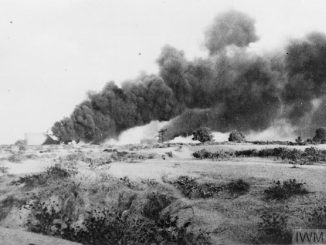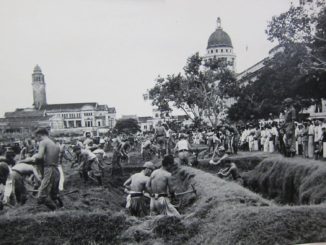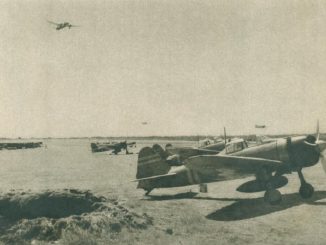
As war waged across the Pacific, one relative backwater saw renewed battle as a veteran Japanese air group duelled with a rookie American unit in the skies of northern Australia. Following the devastating raid on Darwin, in the Northern Territory, on February 19th 1942, Allied commanders had realised the extreme vulnerability of that part of the Australian coast. When the Japanese invaded Timor they took possession of Koepang airfield, which was within easy striking range of Darwin and the surrounding area. With Royal Australian Air Force units hard pressed defending New Guinea, the only available unit was an American fighter group, fresh off the boat from the United States. LtCol Paul Wurtsmith’s 49th Pursuit Group was the first complete US Army Air Force to reach Australia, arriving on the 1st of February, but it was manned by very inexperienced pilots who spent their first few weeks in-country training at airfields in the south.
On the 14th of March the first contingent of the Takao Kokutai under LtCdr Goro Katsumi, with 18 G4M bombers on strength, arrived at Koepang on the island of Timor. There they joined Captain Yoshio Kamei’s 3rd Kokutai, which had already been at Koepang for several weeks with their Zeros and a handful of reconnaissance aircraft. Following the surrender of the Netherlands East Indies the Japanese began to turn their attention more fully against Australia, from where potential counterattacks might be launched. The biggest challenge was the distance between Koepang and Darwin, which was over 500 miles, most of it over open ocean – a very long way to fly, especially with battle damage. The length of the missions rivalled those conducted from Taiwan to Manila earlier in the war, and from Rabaul to Guadalcanal later in 1942.
49th Pursuit Group
While the Japanese were settling in at Koepang, the 49th Pursuit Group was getting its first taste of combat. With Port Moresby at risk and no available Australian fighters, a detachment of Lt Robert Morrissey’s 7th Pursuit Squadron was sent to Horn Island, off the northern coast of Australia and 75 miles south of Moresby. 12 P-40s made the trip, but mechanical problems meant that only 9 arrived safely. The airstrip was so remote that there was no easy way to transport ground crews there, and so the pilots were given rudimentary instruction in maintaining their own aircraft. The 7th PS only had to deal with a single attack by eight 4th Kokutai bombers on the 14th of March, during which they claimed several aircraft shot down. However the primitive conditions took their toll and within days the Americans were reduced to just two airworthy P-40s.
In the aftermath of the attacks on Darwin and Broome, the 49th was ordered to move forward to plug the gap in the northern defences. On the 8th of March the 9th PS began a cross-country flight that required several hops from the rear area to Darwin, with the 7th and 8th to follow. The flights over the 2,000-mile route took several weeks, with many extended stops for weather and repairs to the P-40s. it was not until late March that the 9th arrived at Darwin, only to find that the airfield was still too badly damaged to support the squadron. They therefore moved south to Batchelor Field to take up residence there. The three squadrons gained valuable infusion of experience when 12 pilots who had survived the fall of the Indies joined the 49th. Meanwhile, Australian engineers were busy building several additional airfields along the Stuart Highway, which could be used to disperse the 49th or to act as emergency fields.
The Takao Kokutai had been sending small groups of bombers to attack targets around Darwin without escorts throughout most of March, possible because there was no aerial opposition in the area. That began to change on the 22nd when a C5M reconnaissance aircraft was shot down by 9th PS P-40s. This occurred whilst eight G4Ms were busing bombing the town of Katherine, far inland – in fact this was the deepest penetration of Australia by the Japanese during the entire war. The Japanese were slow to learn from this loss, and six days later sent a formation of 7 unescorted bombers to strike Darwin’s airfield once more. By this time an Australian AW radar set based at Dripstone Cliffs was on the air, and this device directed P-40s of the 9th PS to intercept. The attackers were met out at sea before hitting the target, with the Americans claiming 3 bombers shot down, although only was 1 actually lost. From then on the 3rd Kokutai would be called upon to escort the bombers over Darwin.
Clashes between the 49th PG and the 3rd Ku occurred sporadically in late March, as the Japanese probed with small raids by a handful of bombers. On the 4th of April battle was joined in earnest, when seven G4Ms covered by six Zeroes were intercepted by 14 P-40s. Three bombers fell, but so did two P-40s and another was destroyed on landing – the pilot, 2Lt John Livingstone, was killed. The air strip at the 34 Mile marker on the Stuart Highway was subsequently named in his honour. The Japanese losses were soon made good when the other half of the Takao Ku completed operations in the Philippines and arrived at Koepang, boosting the unit to a nominal strength of 36 bombers. Harassing raids by RAAF Hudson bombers had made Koepang a dangerous place to remain, so the Japanese planned to withdraw back to Kendari and use Timor as a staging base only. Meanwhile the Americans also came up to full strength when the 8th and 9th Pursuit Squadrons joined the 7th PS, reuniting the 49th PG.
Darwin Under Siege
The 25th of April saw the largest raid on Darwin since the devastating February strike. 27 G4Ms covered by 15 Zeroes headed for Darwin’s main airfield. The 49th PG was up in force, with no fewer than 50 P-40s rising to intercept. The Japanese were able to release their bombs on the target before the Americans made their attacks, which were devastating. Four bombers were downed and three more badly damaged, one of which ditched into Dili harbour. Two days later the Takao Ku was back with a beefed up escort, 21 Zeroes covering 16 bombers. The 49th again attacked, by the commander of the 8th PS, Captain Allison Strauss, was shot down and killed. This time only a single G4M was lost but the punishment meted out by the Americans forced a temporary pause to the bombing campaign, and the Takao Ku moved to the safety of Kendari. Darwin was given a six-week reprieve.
When the “rikko” returned in mid-June, they used new tactics to minimise losses. The Takao from now on would attack from higher altitude, over 25,000ft, which reduced bombing accuracy but also lessened the risk from the American Warhawks. They would also have a heavy escort, with 45 Zeroes called in to cover the 27 bombers that set out on the 13th of June. Only a few P-40s were able to intercept after bombs had plastered Darwin’s RAAF base, and they were quickly brushed off by the 3rd Ku with two P-40s being lost. Two Zeroes likewise returned to base, but the bombers escaped with only minor damage. Two days later the Japanese returned, albeit with a smaller escort of just 21 fighters. These flew ahead of the bombers and engaged the (newly renamed) 49th Fighter Group, shooting down two. The bombers hit Darwin town, with eleven suffering damage but all made it safely back to Timor. The very next day the Japanese returned, with an effective escort that cost the 49th three Warhawks and required three more to make forced landings.
Thereafter the Japanese changed tactics again, switching to night raids by small numbers of G4Ms. No nightfighters were yet available and the pilots of the 49th lacked the equipment and training to take on the night intruders, so Darwin’s only defence were several anti-aircraft batteries which had little effect. On the 30th of July the Japanese reverted back to daylight attacks, when 26 bombers again headed for Darwin’s airfield. 27 escorting A6Ms duelled with 36 P-40s which had advance warning of the raid thanks to the RAAF radar crews. A P-40 was shot down but the Americans extravagantly claimed nine enemy machines destroyed, although in reality just a single Zero was lost.
The last major clash between the 49th FG and the Takao and 3rd Kokutai took place on the 23rd of August. This time the target was Hughes Field, an RAAF base inland from Darwin, and again the Takao sent up a full-strength formation of 27 bombers. 36 P-40s had time to scramble and reach intercept altitude, where they were met by 27 Zeroes. One G4M was shot down and another forced to head back to base on one engine. The 49th relied on hit-and-run tactics that confused the 3rd Ku pilots and allowed many opportunities for the Americans, who eventually made claims for 15 enemy aircraft against actual Japanese losses of just five.
With that first bombing season against Darwin drew to a close. The raids had caused limited damage to Darwin, but had prevented the Allies from basing significant numbers of ships in the port. The Takao Ku remained at its base at Kendari but did not launch any significant attacks on the Australian mainland for the remainder of the year, instead launching limited night attacks by small groups of bombers. The Guadalcanal campaign was beginning to ramp up and the Japanese moved reinforcements to Rabaul, including elements of the 3rd Kokutai. The Americans likewise began to re-prioritise, and the 49th Fighter Group began to move to Port Moresby in September. The Americans were replaced by the RAAF’s number 76 and 77 Squadrons, which were likewise equipped with P-40s. Opportunities to engage the Japanese were extremely limited until the following spring of 1943, when a renewed offensive was launched.






Leave a Reply